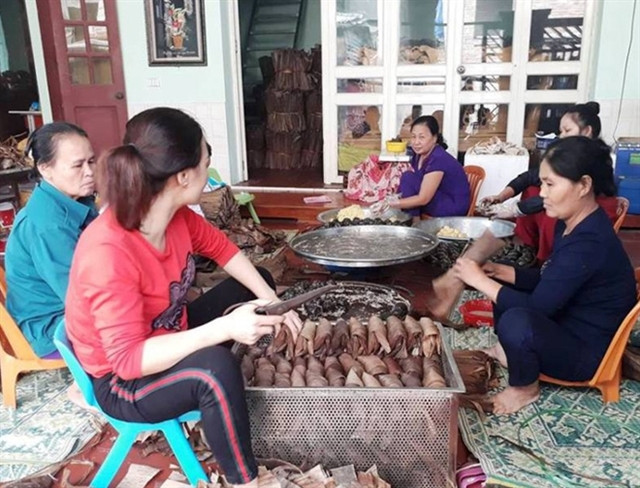Elder Nguyễn Thị Đức, 80, said: “We all call it Tứ Trụ Cake; it has been offered to the kings of the Lê and Nguyễn dynasties since it came into being in the 15th century.”
She said until now, she would never forget her happy memories of when she was a young girl during village festival or Tết (Lunar New Year) holiday, and both young men and girls arrived at the village communal house to grind sticky rice to make bánh gai.
At that time, a young man had to bring a tray of bánh gai to ask a girl to marry him; if lacking this he would never win the agreement of the girl’s parents. Meanwhile, a bride from other places would be taught on how to make the cake by her mother-in-law or grandmother, said Đức.
She recalled her own story: “I married at the age of 20, and just a few days after arriving at my husband’s house, I was taught how to make the cake by my mother-in-law whose name is Ngô Thị Phẩm.
“Phẩm was beloved daughter of Ngô Đình Chí, a mandarin of the Nguyễn Royal Court. Thanks to years living with her parents in Huế Citadel, Phẩm had learned the secret of making superb cakes.
“After leaving the citadel to return to live in her native hamlet Mía, Phẩm taught locals how to make the cake and told them her secret to make the cake tasty,” Đức said.
She said four among her five children carried on the job of making bánh gai. All of her four children have big workshops to make good quality cakes. They sell thousands of cakes to markets and supermarkets across the nation, Đức said.
Asked about ingredients to make the cake, Đức said in the past Mía cooks used only sticky rice varieties called Cai Noại and Mắc Hiển grown in the northern mountains.
“We have to choose ingredients very carefully, such as molasses, mung bean paste and coconuts. But most important is the thorn leaf which determines whether the cake is tasty or not,” Đức said, noting that the thorn leaf must be cut from its stalk and veins, and dried until one side turns a deep black colour while the other has a grey colour.
While the sticky rice is soaked in water for eight to nine hours, the thorn leaves have to boil until well-cooked which helps make the cake pliable and smooth.
After grinding the boiled leaves, they are cooked with molasses until thick, mixed with sticky rice wet powder and then fermented for 12 hours. The mixture is then cut into balls about as big as a duck egg.
To make the dumpling, the cook mixes mung bean paste with coconut threads, making balls the size of a small chicken egg before putting it into the above mixture, rolling it on sesame and finally wrapping it up in dried banana leaves.
 |
| Mía cooks wrapping up thorn leaf cakes. — Photo cand.com.vn |
Đức said Mía cooks steamed the wrapped cakes over a wood fire for about one hour.
The specialty rural cake is best enjoyed when eaten in cool weather, Đức advised.
Lê Văn Đước from the southern province of Cà Mau told Việt Nam News that he likes the Tứ Trụ cake so much. “I often order the thorn leaf cake from Thanh Hóa Province to worship my grandparents at their death anniversary or at traditional Tết festival.”
The cake has been ranked among the top ten specialties of Thanh Hóa for many years. VNS